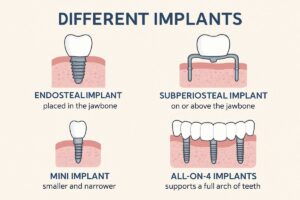If you’re missing one or more teeth, implants for teeth are a long-term solution that looks and feels natural. In 2024, modern digital tools make implant treatment more predictable and faster than before. This 800-word guide explains what implants for teeth are, who makes a good candidate, the types and steps of treatment, risks and care, cost, and where to get digital implant care near you.
What are implants for teeth?
Dental implants are small titanium or zirconia posts placed in the jaw to replace tooth roots. An implant has three parts: the implant (fixture), an abutment that connects the implant to the tooth, and the crown or prosthesis that replaces the visible tooth. Unlike bridges or dentures, implants fuse with bone and act like real roots. That gives better chewing, stable fit, and helps prevent bone loss.
Who is a good candidate for implants for teeth?
Bone and gum health
Good jawbone and healthy gums make implants more likely to succeed. If bone is low, bone grafting or sinus lifts can rebuild volume. Many patients who once couldn’t get implants can now because of grafting and modern planning tools.
Medical and lifestyle factors
Certain conditions affect success. Poorly controlled diabetes, heavy smoking, and some medications can raise risks. Your dentist will review your health and may recommend lifestyle changes, like quitting smoking, before treatment.
Age and general health
Adults of many ages can get implants. Younger patients should have fully grown jaws. Older adults are often good candidates if overall health is stable. Medical clearance may be needed for some health issues.
Types of implants for teeth and prosthetic options
There are options depending on how many teeth you need to replace:
- Single-tooth implant: replaces one tooth with one implant and a crown.
- Implant-supported bridge: uses two or more implants to hold a bridge for several missing teeth.
- Implant-retained or implant-supported dentures: full-arch prostheses that snap or screw onto implants.
Full-arch solutions like All-on-4 use four or more implants to support a whole arch and are common for people who want fixed teeth. Materials include titanium (widely used) and zirconia (metal-free option). Choice affects strength, look, and cost.
The implant process: step-by-step
Digital planning and imaging
Today many practices use CBCT scans and digital implant planning software to map bone and nerves. This planning improves accuracy and safety and lets you see the proposed result before surgery.
Guided surgery and placement
Surgeons often use 3D-printed surgical guides to place implants exactly where planned. Sedation options range from local anesthesia to IV sedation to keep you calm and comfortable. The day of surgery is usually well controlled and quicker with guided workflows.
Healing and restoration
After placement the implant needs time to fuse to bone—a process called osseointegration—usually several months. Then the abutment and final crown, bridge, or denture are placed. Some patients qualify for immediate temporary teeth on the day of surgery.
Risks, success rates, recovery, and long-term care
Short-term side effects can include swelling, mild pain, and bruising. Watch for signs of infection, persistent pain, or loose implants and contact your dentist. Success rates for implants are high—often above 95%—when patients maintain good oral hygiene and follow care instructions. Quitting smoking and treating gum disease improve outcomes.
Daily care is like natural teeth: brush twice, floss carefully around implants, and see your dentist for regular checkups and cleanings. With good care, implants can last many years or a lifetime.
Cost, insurance, and ways to afford implants for teeth
Costs vary by number of implants, need for grafting, type of prosthesis, and whether digital workflows are used. Single implants cost less than full-arch restorations. Insurance may cover part of the cost, but many plans limit implant benefits. Practices often offer financing, payment plans, or in-house options. Digital planning and in-house 3D printing can lower time and lab fees, helping reduce overall cost.
About Flathead Dental Implant Arts and Dr. Dave Dodrill
Flathead Dental Implant Arts in Kalispell offers modern implant care led by Dr. Dave Dodrill. Dr. Dodrill graduated cum laude with a DDS from Virginia Commonwealth University and completed advanced training at Idaho State University. He is a published author, keynote speaker, and active volunteer in the Flathead Valley.
The practice uses CBCT imaging, digital implant planning software, in-house 3D printing for surgical guides, guided-surgery workflows, CAD-CAM prosthetics, and sedation options. These technologies improve precision, reduce treatment time, and increase comfort during implant procedures.
Next steps and brief CTA
If you think implants for teeth in Kalispell might be right for you, schedule a consultation. Bring a list of medical conditions, current medications, and any recent dental records or X-rays. During the visit you’ll get a CT scan if needed, a treatment plan, cost estimate, and answers to your questions.
Ready to learn more? Call Flathead Dental Implant Arts or book an appointment to discuss implants for teeth in Kalispell. A consultation will tell you if implants are the best long-term option for your smile.




